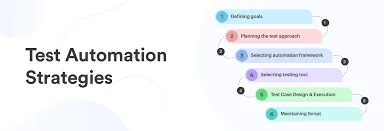
Automation testing has particularly changed the software development industry and has become essential to software testing. Jest, a widely-used automation testing framework for JavaScript applications, is among the most popular and highly preferable by developers. Developing and Implementing a robust automated testing strategy with Jest can help QAs streamline and improve their testing process. This will not only ensure that software application meet the required quality standards but also ensure they are bug-free.
However, achieving a successful automation testing strategy requires considering several factors. For example, QA must define the scope of testing, choose the appropriate test cases to automate, and follow a broad approach to provide an effective testing process.
This blog will walk you through the five steps to building a successful automated testing strategy using Jest.
Evaluate Your Testing Needs
Developing an effective automated testing strategy with Jest requires a systematic approach. The initial step involves assessing your testing requirements thoroughly. This includes a detailed analysis of your project’s unique demands and identifying potential sources of failure and associated risks. By conducting such an evaluation, you can determine the types of tests required, the frequency of their execution, and the tools and resources necessary to support your testing endeavors. This process ensures that your testing strategy is aligned with your project’s objectives and optimizes your testing outcomes.
When planning an automation testing strategy, it is crucial to assess the appropriate level of automation and any constraints that may impact its implementation. Careful evaluation of your testing needs is key to designing and executing an effective automation testing plan that aligns with your goals and delivers top-notch software products.
Determine the Scope of Your Tests
The next crucial aspect of developing a successful automated testing strategy using Jest is defining the scope of your tests. This process is necessary to identify and determine the specific functionalities, components, and areas that require testing. This step ensures a comprehensive and efficient testing process. Ascertaining the scope of your tests will enable you to establish a definitive plan for your automation testing efforts.
To ensure the quality of your application, it is crucial to perform a comprehensive risk assessment to identify areas susceptible to errors and test failures. Prioritize these areas and determine the appropriate types of tests that will cover them. Both functional and non-functional testing, such as performance, security, and usability testing, should be considered. Defining the scope of your tests clearly will enable you to focus your automation testing efforts effectively and ensure that the quality of your application is enhanced.
Establish the Necessary Tools and Frameworks to Support Your Testing
Establishing an effective automated testing strategy using Jest involves identifying the essential tools and frameworks to facilitate your testing endeavors. The initial step in this procedure is to recognize the requisite testing tools, including widely utilized Selenium WebDriver for automated web applications or Appium for automating mobile applications.
To leverage the true capability of the automation test with Jest, using a cloud-based platform is the most preferred option by the developers. One of the most used cloud-based platforms is LambdaTest which helps you to build a successful automated testing strategy with Jest. You can easily perform automated tests on your web applications, ensuring that they are thoroughly tested and ready for release. LambdaTest can easily integrate with Jest, allowing you to run your tests in a scalable cloud-based environment without needing any local infrastructure.
Further, LambdaTest is a digital experience testing that provides access to 3000+ browsers and devices, helping you to test your web applications across multiple platforms and devices, ensuring that they work as per user expectations.
After identifying the necessary tools for executing automated tests, it is imperative to establish an efficient framework for organizing and conducting the tests. One can opt for a framework such as TestCafe or Cypress, equipped with built-in features for running and reporting on automated tests. By having a robust set of tools and frameworks, you can streamline your automation testing strategy resulting in improved efficiency, accuracy, and optimal utilization of testing resources.
Choose the Appropriate Configuration
Selecting the most appropriate configuration is fundamental in establishing an effective automated testing strategy with Jest. Ensuring this is crucial for the smooth and effective execution of test suites. The appropriate configuration enables prompt identification and resolution of bugs and other concerns throughout the development lifecycle. To ensure a proper test environment, it is imperative to configure Jest to run in the appropriate mode that meets your specific needs.
Jest has various modes for running tests, including watch mode and coverage mode. The appropriate mode selection significantly enhances test speed and efficiency. It is also necessary to consider other configurations like test-specific modules, environment variables, and browser configurations. Investing the required effort in selecting the appropriate configuration will enhance productivity and save time by enabling quick and effortless bug detection and resolution.
Implement a Test Automation Plan and Create Test Scripts
Establishing a proficient automated testing strategy utilizing Jest requires implementing a well-crafted test automation plan. This approach is critical in minimizing errors and expediting the testing process. An essential element of executing an effective automation plan is identifying significant tests, prioritizing them, and determining which ones can be automated. Additionally, it is crucial to establish the frequency of running these automated tests and outline a reporting mechanism for their results.
An effective automation plan should incorporate various testing approaches, such as API testing, database testing, and user interface testing. This cohesive and thoughtful plan will ensure that your automated testing is well-organized, runs smoothly, and provides valuable insights to your team.
Further, creating precise test scripts for each test included in the automation testing strategy is important. As a developer, you should develop test scripts that mimic actual user scenarios. A recommended best practice for creating test scripts is to make them modular and independent of each other to ensure that each script is self-containing and not reliant on the output of another script.
Creating scripts that yield optimal test coverage is essential in achieving a comprehensive testing strategy. The objective of the testing approach is to proactively detect and eliminate potential defects before they adversely affect the end-user experience. Hence, the test scripts should focus on functional requirements and include negative testing and edge-case scenarios. Developing well-structured and all-inclusive test scripts will enable successful automation testing with Jest and guarantee the delivery of top-notch software.
Bonus Tip: Monitor and Update Tests for Continuous Improvement
Implementing an automated testing strategy utilizing Jest requires consistent monitoring and updating of tests. Once the initial test suite has been established, it is imperative to regularly review the test outcomes to ensure their accuracy and reliability. The corresponding tests must be updated or rewritten as the codebase evolves to retain their efficacy. In case of any complications, identifying the root cause is crucial to modify the tests appropriately.
Regular monitoring and updating of tests can assist in identifying potential vulnerabilities and performance issues in your application. By proactively addressing these concerns, developers can prevent them from escalating into more significant problems. Consistently monitoring and updating your tests ensures that your automation testing strategy remains effective and provides dependable results throughout the software development lifecycle. Adopting this approach is crucial in maintaining a professional and comprehensive testing process.
Benefits of Building A Successful Automation Testing Strategy With Jest
Having an efficient automated testing strategy is paramount in modern software development. Jest enables developers to create automated tests that execute rapidly and deliver precise outcomes. The following advantages highlight the significance of incorporating Jest in the automation testing strategy:
Improve Code Quality: Jest automated testing procedures, authorizing developers to identify issues earlier in the development cycle. Any bugs or errors can be fixed before they become major problems, saving time and resources in the long run. By improving code quality, Jest helps developers build reliable and stable applications that meet end-users expectations.
Save Time and Money: Manual testing can be laborious and costly. However, Jest offers developers an efficient solution. With Jest, developers can create and execute tests with ease. This enables them to detect and address bugs promptly, reducing the likelihood of expensive errors. Ultimately, this streamlines the development process, saves valuable time and resources, and increases the possibility of delivering high-quality software within budget and on schedule.
Reliable and Consistent Testing Process: Jest authorizes the creation of automated tests that can be run consistently and reliably on various platforms. By incorporating automation into their testing processes, developers can run tests more frequently and consistently across diverse environments, thus ensuring the software is thoroughly and dependably tested at every stage of development.
Faster Feedback and Shorter Release Cycles: By automating your testing with Jest, you can get faster feedback on your software’s performance, functionality, and security. This helps you identify issues early on and fix them before they become more significant problems. Moreover, faster feedback means shorter release cycles, enabling you to deploy new features and updates to your software more frequently.
Scalability: The codebase can become increasingly intricate as software development projects expand. Jest provides a solution by enabling scalable and maintainable testing, facilitating adaptation to shifting application demands. Additionally, Jest supports simultaneous testing on multiple machines, expediting the process while freeing development resources.
Accuracy: Jest offers precise testing outcomes, facilitating developers in detecting and resolving problems efficiently. With its automated testing mechanism, Jest guarantees consistent and accurate testing every time. This approach eliminates the likelihood of human errors that may result in erroneous positive or negative test results.
Conclusion
Building a successful automated testing strategy with Jest requires careful planning and execution. Developers can significantly benefit from these five steps, from identifying critical test cases to creating reusable test modules. With Jest’s suite of features and functionalities, developers can create robust and reliable test scripts to streamline their testing process and improve software quality. With the growing importance of automation testing in modern software development, mastering the art of automation testing with Jest can help developers stay competitive and deliver high-quality applications.
